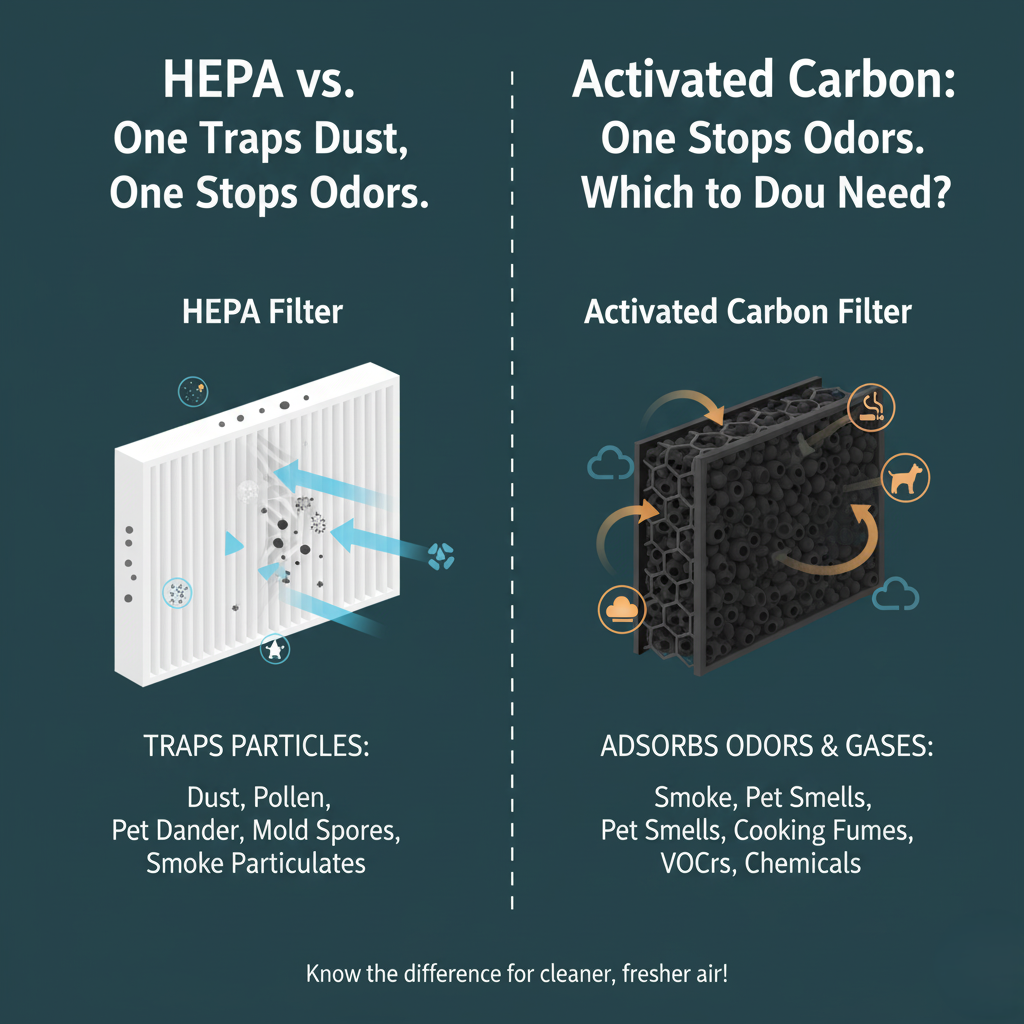When you start researching air purifiers, you quickly encounter two terms that pop up repeatedly: HEPA and Activated Carbon. Both are essential components of many high-quality air purification systems, but they tackle completely different types of airborne pollutants.
Understanding their distinct roles is key to choosing the right air purifier for your specific needs. Let's break down the HEPA vs. Activated Carbon debate once and for all.
The Particle Catcher: HEPA Filters
As we discussed, a HEPA (High-Efficiency Particulate Air) filter is designed to capture microscopic airborne particles. Think of it as a highly efficient net for physical matter floating in your air.
What HEPA filters excel at removing:
Dust & Dust Mites: The common culprits in every home.
Pollen: A major trigger for seasonal allergies.
Pet Dander: Tiny skin flakes from animals that cause pet allergies.
Mold Spores: Microscopic seeds released by mold.
Smoke Particles: Though they don't remove the smell, they capture the solid particulate matter from smoke (e.g., wildfire smoke, cigarette smoke).
Bacteria & Viruses: HEPA filters can trap many bacteria and virus-carrying droplets that are suspended in the air.
How they work: HEPA filters consist of a dense, intricate web of fine fibers that physically trap particles using impaction, interception, and diffusion. They don't absorb gases or chemicals; they capture solid and liquid particles.
Why you need it: If you suffer from allergies, asthma, or simply want to reduce dust and airborne irritants in your home, a True HEPA filter is non-negotiable.
The Odor & Gas Eliminator: Activated Carbon Filters
While HEPA filters are particle specialists, Activated Carbon filters are the champions of removing gases, odors, and Volatile Organic Compounds (VOCs) from the air. They work on a completely different principle called adsorption.
What Activated Carbon filters excel at removing:
Pet Odors: That distinct "dog smell" or cat litter box aroma.
Cooking Smells: Lingering odors from last night's dinner (fish, garlic, fried foods).
Smoke Odors: From cigarettes, cigars, or fireplaces (the gaseous components, unlike HEPA which removes particulates).
VOCs (Volatile Organic Compounds): Harmful chemicals emitted from paints, cleaning products, new furniture ("new car smell"), carpets, and building materials.
Gases & Fumes: General household chemical fumes.
How they work: Activated carbon is charcoal that has been treated with oxygen to open up millions of tiny pores between the carbon atoms. This process dramatically increases the surface area. When gases, odors, or chemicals pass through, they get chemically attracted and adsorbed (stuck) onto this vast surface. Think of it like a sponge for smells and invisible gases.
Why you need it: If you have pets, cook frequently, are sensitive to chemical smells, live in an area with air pollution from cars or industry, or want to reduce off-gassing from new products, an activated carbon filter is essential.
Do I Need Both? (Short Answer: Probably Yes!)
For optimal indoor air quality, the most effective strategy is to have an air purifier that incorporates both a True HEPA filter and a robust Activated Carbon filter.
Here's why:
HEPA handles the visible (and invisible) particles: Dust, pollen, dander, mold, bacteria, viruses.
Activated Carbon handles the invisible (and often smelly) gases: Odors, smoke smell, VOCs.
Most high-quality air purifiers are designed with a multi-stage filtration system that includes both. Often, there's also a pre-filter to catch larger particles and extend the life of the HEPA and carbon filters.
When you might prioritize one over the other (though still recommend both):
Severe Allergies/Asthma, but no strong odors: Focus on a strong True HEPA.
Heavy smoking household or strong pet odors, but no known particle sensitivities: Focus on a substantial Activated Carbon filter.
However, since most homes deal with a combination of dust, allergens, and occasional odors or chemicals, a system with both will give you the most comprehensive protection.
Conclusion
HEPA and Activated Carbon filters are like a dynamic duo for your indoor air. HEPA tackles the physical stuff that irritates your lungs and triggers allergies, while Activated Carbon cleans up the unseen gases and unpleasant smells. By understanding their unique functions, you can make an informed decision to breathe easier and enjoy a truly fresh home environment.





